1990 VOLVO 240 light
[x] Cancel search: lightPage 115 of 143
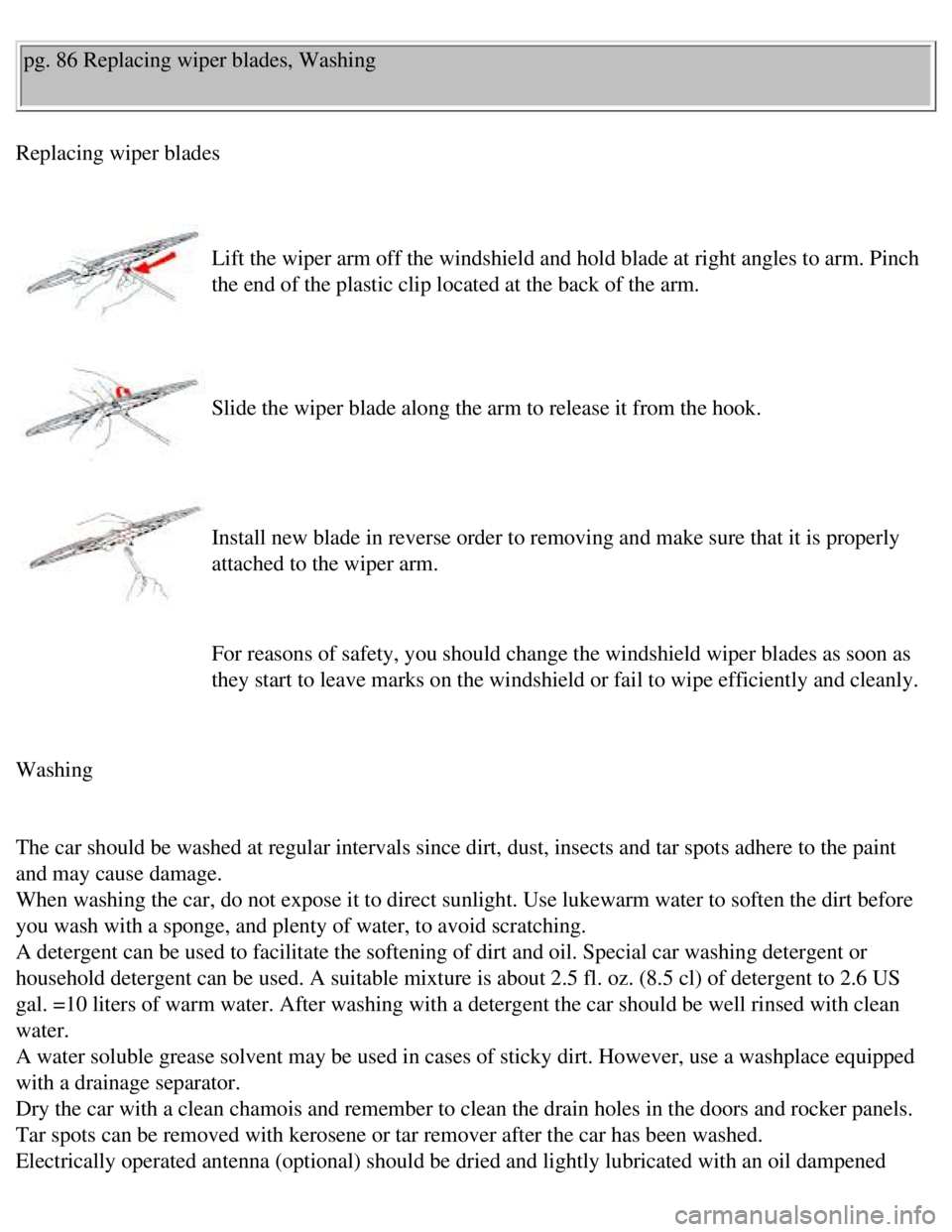
Volvo 1990 240 Model
pg. 86 Replacing wiper blades, Washing
Replacing wiper blades
Lift the wiper arm off the windshield and hold blade at right angles to \
arm. Pinch
the end of the plastic clip located at the back of the arm.
Slide the wiper blade along the arm to release it from the hook.
Install new blade in reverse order to removing and make sure that it is \
properly
attached to the wiper arm.
For reasons of safety, you should change the windshield wiper blades as \
soon as
they start to leave marks on the windshield or fail to wipe efficiently \
and cleanly.
Washing
The car should be washed at regular intervals since dirt, dust, insects \
and tar spots adhere to the paint
and may cause damage.
When washing the car, do not expose it to direct sunlight. Use lukewarm \
water to soften the dirt before
you wash with a sponge, and plenty of water, to avoid scratching.
A detergent can be used to facilitate the softening of dirt and oil. Spe\
cial car washing detergent or
household detergent can be used. A suitable mixture is about 2.5 fl. oz.\
(8.5 cl) of detergent to 2.6 US
gal. =10 liters of warm water. After washing with a detergent the car sh\
ould be well rinsed with clean
water.
A water soluble grease solvent may be used in cases of sticky dirt. Howe\
ver, use a washplace equipped
with a drainage separator.
Dry the car with a clean chamois and remember to clean the drain holes i\
n the doors and rocker panels.
Tar spots can be removed with kerosene or tar remover after the car has \
been washed.
Electrically operated antenna (optional) should be dried and lightly l\
ubricated with an oil dampened
file:///K|/ownersdocs/1990/1990_240/90240_18.htm (1 of 8)12/30/2006 8:\
25:11 AM
Page 118 of 143
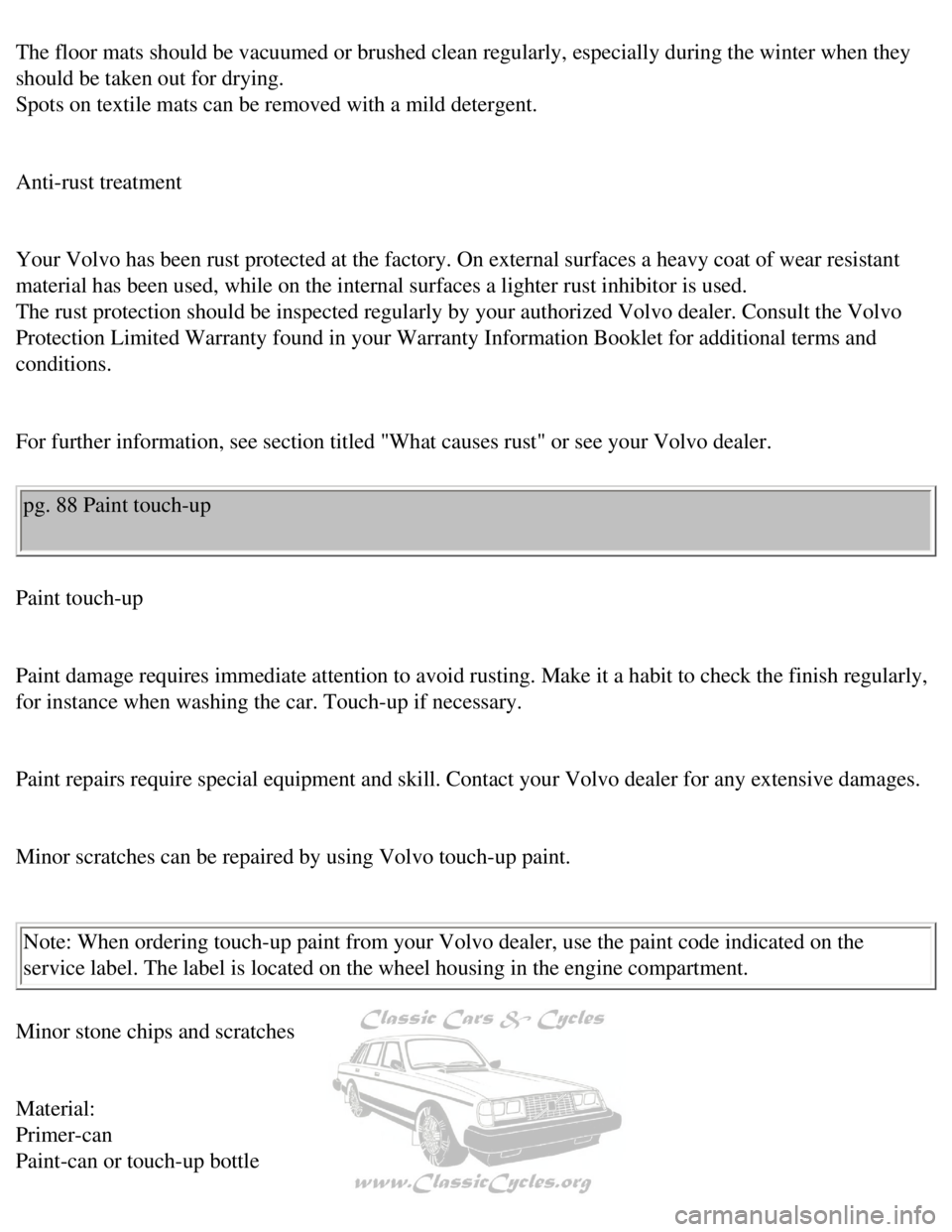
Volvo 1990 240 Model
The floor mats should be vacuumed or brushed clean regularly, especially\
during the winter when they
should be taken out for drying.
Spots on textile mats can be removed with a mild detergent.
Anti-rust treatment
Your Volvo has been rust protected at the factory. On external surfaces \
a heavy coat of wear resistant
material has been used, while on the internal surfaces a lighter rust in\
hibitor is used.
The rust protection should be inspected regularly by your authorized Vol\
vo dealer. Consult the Volvo
Protection Limited Warranty found in your Warranty Information Booklet f\
or additional terms and
conditions.
For further information, see section titled "What causes rust" or see yo\
ur Volvo dealer. pg. 88 Paint touch-up
Paint touch-up
Paint damage requires immediate attention to avoid rusting. Make it a ha\
bit to check the finish regularly,
for instance when washing the car. Touch-up if necessary.
Paint repairs require special equipment and skill. Contact your Volvo de\
aler for any extensive damages.
Minor scratches can be repaired by using Volvo touch-up paint.
Note: When ordering touch-up paint from your Volvo dealer, use the paint\
code indicated on the
service label. The label is located on the wheel housing in the engine c\
ompartment.
Minor stone chips and scratches
Material:
Primer-can
Paint-can or touch-up bottle
file:///K|/ownersdocs/1990/1990_240/90240_18.htm (4 of 8)12/30/2006 8:\
25:11 AM
Page 123 of 143

Volvo 1990 240 Model
pg. 91 Long distance trips, Cold weather
Prior to a long distance trip
Have your car checked at a Volvo dealer. Preventive maintenance will hel\
p to ensure a trouble free trip.
Remember to take along a Volvo dealer directory.
The main items to check are listed below:
1. Brakes, front wheel alignment and steering gear.
2. Engine running condition.
3. Fuel system operation.
4. Oil leaks: engine, transmission, rear axle.
5. Cooling system for leaks or worn hoses.
6. Examine tires carefully, replace worn tires.
7. Battery and terminals.
8. Tool equipment.
9. Lighting.
10. Drive belts, for tightness and wear.
11. All fluid levels.
Cold weather/Engine fuel system
During the winter, large variations in temperature cause condensation to\
form in the fuel tank and can
impair the running of the engine. This can be reduced by adding dry gas \
to the fuel. There is less risk of
condensation forming in the fuel tank if it is kept full or nearly full.\
Engine cooling system
Volvo type C (blue-green) coolant should be used all year round. The c\
ooling system should always
contain water plus anti-freeze and rust inhibitor, even during the summe\
r. Experience has also shown
that extremely weak anti-freeze solutions (10-25 percent) are ineffect\
ive for rust protection. For this
reason, the quantity of antifreeze/summer coolant should be about 50 per\
cent of the solution. This
lowers the freezing point to - 30 ° F (-35 ° C).
Engine lubricating system
file:///K|/ownersdocs/1990/1990_240/90240_19.htm (1 of 7)12/30/2006 8:\
25:13 AM
Page 124 of 143
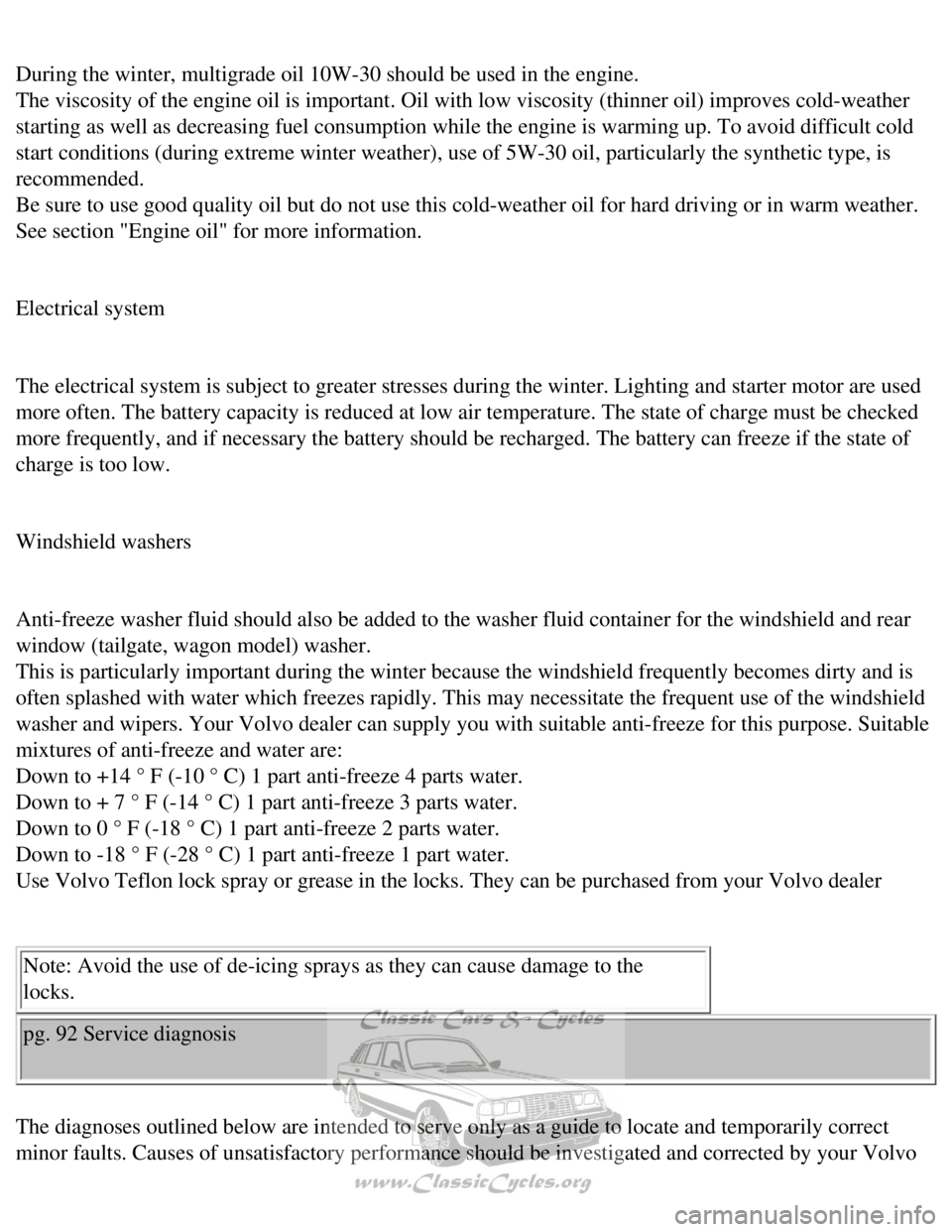
Volvo 1990 240 Model
During the winter, multigrade oil 10W-30 should be used in the engine. \
The viscosity of the engine oil is important. Oil with low viscosity (t\
hinner oil) improves cold-weather
starting as well as decreasing fuel consumption while the engine is warm\
ing up. To avoid difficult cold
start conditions (during extreme winter weather), use of 5W-30 oil, pa\
rticularly the synthetic type, is
recommended.
Be sure to use good quality oil but do not use this cold-weather oil for\
hard driving or in warm weather.
See section "Engine oil" for more information.
Electrical system
The electrical system is subject to greater stresses during the winter. \
Lighting and starter motor are used
more often. The battery capacity is reduced at low air temperature. The \
state of charge must be checked
more frequently, and if necessary the battery should be recharged. The b\
attery can freeze if the state of
charge is too low.
Windshield washers
Anti-freeze washer fluid should also be added to the washer fluid contai\
ner for the windshield and rear
window (tailgate, wagon model) washer.
This is particularly important during the winter because the windshield \
frequently becomes dirty and is
often splashed with water which freezes rapidly. This may necessitate th\
e frequent use of the windshield
washer and wipers. Your Volvo dealer can supply you with suitable anti-f\
reeze for this purpose. Suitable
mixtures of anti-freeze and water are:
Down to +14 ° F (-10 ° C) 1 part anti-freeze 4 parts water.
Down to + 7 ° F (-14 ° C) 1 part anti-freeze 3 parts water.
Down to 0 ° F (-18 ° C) 1 part anti-freeze 2 parts water.
Down to -18 ° F (-28 ° C) 1 part anti-freeze 1 part water.
Use Volvo Teflon lock spray or grease in the locks. They can be purchase\
d from your Volvo dealer
Note: Avoid the use of de-icing sprays as they can cause damage to the
locks.
pg. 92 Service diagnosis
The diagnoses outlined below are intended to serve only as a guide to lo\
cate and temporarily correct
minor faults. Causes of unsatisfactory performance should be investigate\
d and corrected by your Volvo
file:///K|/ownersdocs/1990/1990_240/90240_19.htm (2 of 7)12/30/2006 8:\
25:13 AM
Page 125 of 143

Volvo 1990 240 Model
dealer.
Condition: Starter fails to operate (or operates very slowly)
Possible cause Correction
Weak battery or dead cell. With the starting (ignition) switch in the "Driving"
or "On" position, check to see if the warning lights
on the dashboard come on and if they stay on when
the starter is engaged. If the lights do not come on or
if they go off when the starter is engaged, the battery
is discharged or see below.
Loose or corroded battery cable terminals. Check battery terminals and clamps. Clean or
replace if necessary. Check that the starter cable is
secure at its terminals.
The ground strap, which connects the battery
negative (-) terminal to the engine, should also be
checked for corrosion or looseness.
Open circuit between starting (ignition) switch
and starting (ignition) switch terminal on
starter. The circuit is closed if a clicking sound is heard
from the starter when it is engaged. If no clicking
sound is heard, check that the blue wire at the starter
is secure. If still no clicking sound is heard, the
starting (ignition) switch or the wire is defective.
Starter motor defective. If the above checks have been performed, and no
fault is evident, the starter may be defective. NOTE:
In this case the headlight intensity will not dim when
the starter is engaged.
pg. 93 Service diagnosis
Condition: Starter motor operates but engine does not start
file:///K|/ownersdocs/1990/1990_240/90240_19.htm (3 of 7)12/30/2006 8:\
25:13 AM
Page 137 of 143
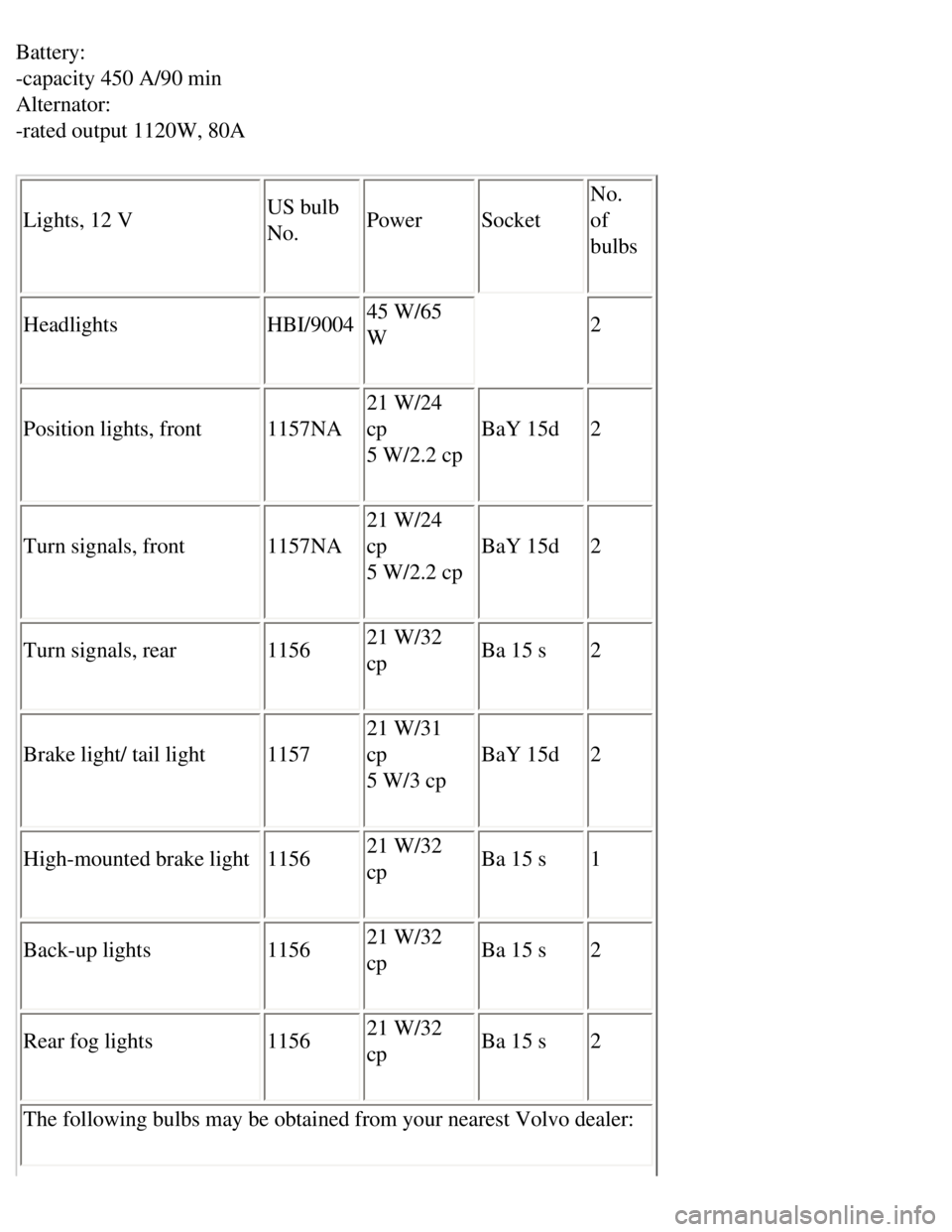
Volvo 1990 240 Model
Battery:
-capacity 450 A/90 min
Alternator:
-rated output 1120W, 80A Lights, 12 V US bulb
No. Power
Socket No.
of
bulbs
Headlights HBI/9004 45 W/65
W 2
Position lights, front 1157NA 21 W/24
cp
5 W/2.2 cp BaY 15d
2
Turn signals, front 1157NA 21 W/24
cp
5 W/2.2 cp BaY 15d
2
Turn signals, rear 1156 21 W/32
cp Ba 15 s
2
Brake light/ tail light 1157 21 W/31
cp
5 W/3 cp BaY 15d
2
High-mounted brake light 1156 21 W/32
cp Ba 15 s
1
Back-up lights 1156 21 W/32
cp Ba 15 s
2
Rear fog lights 1156 21 W/32
cp Ba 15 s
2
The following bulbs may be obtained from your nearest Volvo dealer:
file:///K|/ownersdocs/1990/1990_240/90240_20.htm (8 of 14)12/30/2006 8\
:25:15 AM
Page 138 of 143
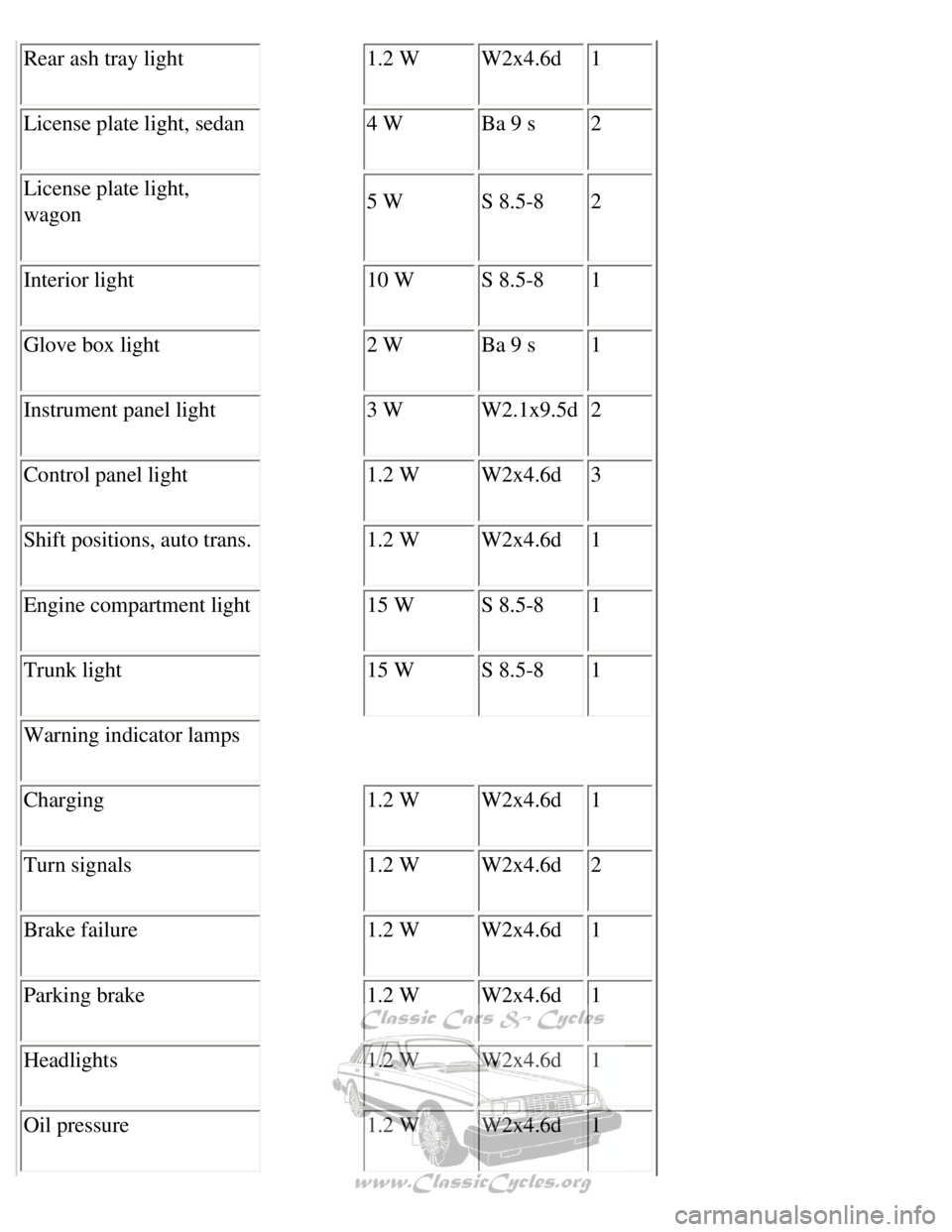
Volvo 1990 240 Model
Rear ash tray light 1.2 W W2x4.6d 1
License plate light, sedan 4 W Ba 9 s 2
License plate light,
wagon 5 W
S 8.5-8 2
Interior light 10 W S 8.5-8 1
Glove box light 2 W Ba 9 s 1
Instrument panel light 3 W W2.1x9.5d 2
Control panel light 1.2 W W2x4.6d 3
Shift positions, auto trans. 1.2 W W2x4.6d 1
Engine compartment light 15 W S 8.5-8 1
Trunk light 15 W S 8.5-8 1
Warning indicator lamps
Charging 1.2 W W2x4.6d 1
Turn signals 1.2 W W2x4.6d 2
Brake failure 1.2 W W2x4.6d 1
Parking brake 1.2 W W2x4.6d 1
Headlights 1.2 W W2x4.6d 1
Oil pressure 1.2 W W2x4.6d 1
file:///K|/ownersdocs/1990/1990_240/90240_20.htm (9 of 14)12/30/2006 8\
:25:15 AM